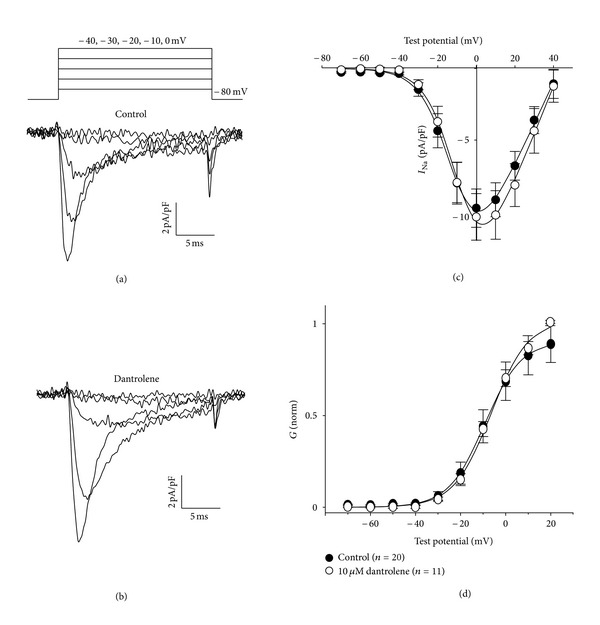Figure 1.

Dantrolene does not affect the I-V relationship in of the fast skeletal muscle Na+ current. Representative recordings of skeletal I Na elicited by 20 ms depolarizations from the steady holding potential of −80 mV to the indicated test potentials (illustrated at top) are shown for untreated control myotubes (a) and myotubes exposed to 10 μM Dantrolene (b). (c) Comparison of peak I-V relationships for control (⚫; n = 20) and Dantrolene-treated (⚪; n = 11) myotubes. Currents were evoked at 0.1 Hz by test potentials ranging from −70 mV through +40 mV in 10 mV increments. Peak current amplitudes were normalized by linear cell capacitance (pA/pF). Smooth I-V curves were fit by (1) (see “Section 2”) with the following respective parameters for control and Dantrolene-treated groups: G max = 305 ± 43 and 355 ± 44 nS/nF; V 1/2 = −9.8 ± 1.7 and −7.4 ± 1.3 mV; k = 6.9 ± 0.3 and 7.2 ± 0.2 mV. (d) comparison of conductance-voltage relationships for control and Dantrolene-treated myotubes. The average normalized conductance values (derived from I-V data using (2); see Section 2) were fit by (3) with the following respective parameters for control and Dantrolene-treated groups: V 1/2 = −9.9 ± 1.8 and −5.9 ± 3.0 mV; k = 6.9 ± 0.3 and 7.9 ± 1.0 mV. Throughout, data are given as mean±SEM, with the numbers in parentheses indicating the number of myotubes tested. For all the data given, the calculated average voltage error was <5 mV.
